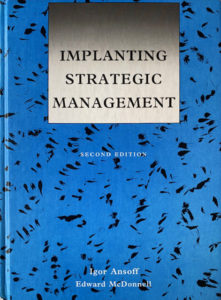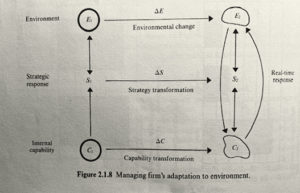From The Strategic Thought by Igor Ansoff
“A natural companion to the competitive advantage is the synergy component of strategy. This requires that opportunities within the scope possess characteristics which will enhance synergy”.
— Igor Ansoff, the father of strategic management


This presentation is based on Ansoffian – i.e. relative to Igor Ansoff, editor’s note – terms from his theoretical concept “Strategic Success Paradigm”.
How will you think? (How will you work? How will you collaborate?)
I think I’ll pick them all, if I may do so. I believe they all constitute a new philosophy of life in its complete holistic context, which affects and transforms our daily actions and behaviors.
Earlier this year, we all experienced a drastic event that changed the way the world once lived — regardless of our nationality, regardless of our color, our religion, our culture. The Covid-19 pandemic produced a drastic effect that affected everyone and damaged the core of mankind: our living existence.
We are now living in a time when everything is new, “the era of rebirth”, to quote Michelangelo Pistoletto.
Any new idea, any new model, new perspective and even new concepts (much of the pre-Covid-19 terminology have become obsolete in the new reality) must start from a source, the ‘core’.
Similarly, the nature and the framework of the collaborations will also change their vision and direction towards more inclusive, multidisciplinary, synergistic, transversal and multidimensional approaches. Models of shared participation. As an “involved universe” (a concept development by the Rebirth/Third Paradise ambassador Raymundo Sesma).
We are therefore in a moment of reinvention of models of collaboration.
Michelangelo Pistoletto’s philosophy and the Trinamic principle fit exactly at the center of the core of the strategic design model I am presenting.
Strategic Success Paradigm
Ansoff used the model of turbulence to construct a strategic success paradigm based on three variables: the turbulence levels of the organization’s environment; the aggressiveness of the organization’s strategic behavior in the environment; and the responsiveness of the organization’s management to changes to the environment.
The paradigm states that the financial performance of an organization is optimized when the aggressiveness and management responsiveness of the organization both match the turbulence of the organization’s environment (1979).
Strategic diagnosis identifies whether an organization needs to change its strategic behavior to ensure success in its future environment. If the diagnosis confirms the need, the next step is to select and execute specific actions that will bring the organization’s aggressiveness and responsiveness in line with the future environment.

Implanting Strategic Management. Second Edition. Igor Ansoff, Edward McDonnell. 1990.
Corporate Strategy. Igor Ansoff. Assisted by Edward McDonnell, and with an introduction by J.H. Harvey-Jones 1965.
The Contingent Strategic Success Paradigm includes analysis of the environment, strategic diagnosis, real-time strategic control mechanism, implementation and models that present tools for managing organizational transformation.
The ideal strategic design: a ‘tailor made’ model
A unique formula that constitutes the design and structure that derives from the Ansoffian methodology, and which in turn comes from the praxis of Michelangelo Pistoletto’s school of thought.
The structure of the design follows the system of the body, and therefore, each function – in an organic way – becomes an essential part of the whole. It is a unique formula in that once elaborated it will offer Cittadellarte potential for future development and strategic positioning.
And then there is the area that I like to call the ‘area of uniqueness’ (the DNA): the area of uniqueness is the academic structure that derives from Michelangelo Pistoletto’s theoretical concept (his philosophy, the Rebirth Embassies and the Third Paradise, UNIDEE, the themes and concepts that make up his school of thought); with this, openness towards the creation of cultural, artistic, academic and commercial programs and collaborations, connecting and integrating different sectors and actors of society in different corners of the world. An opening that does not stop at what is created in the present in an evolutionary way, but proposes a transparent platform for the continuous creation of tomorrow.
As a result, there is no design model that works for everyone. Each design that is developed has its own specific variables (DNA). Each model has a sub-model that presents unique opportunities at every level and from every angle, aligning theory, mission, values and goals with the vision of the school of thought – in perfect harmony.
Synergy and connection
Each component of the strategic design is organically synchronized in an orchestral way, creating a melody in which each step, each phase of the process, rhythmically, follows what is next, and each component and each step becomes a complement to the whole – reaching a level of balance and harmony.
So what do I mean by design and structure?
Design: a strategic model that draws the skeleton (holistic framework) of Cittadellarte and for Cittadellarte.
Structure: the holistic structure of Cittadellarte.
1. Italy “helicopter view”
Biella – Cittadellarte – Unidee – Rebirth/Third Paradise Embassies: the structure that includes activities in the areas of operations, administration, strategy, academic development, international development and collaboration, artistic / cultural initiatives, social initiatives and events, marketing and promotion, including the others.
The rest of Italy: Cittadellarte / UNIDEE / the Third Paradise platform in Biella and opportunities in the rest of the Italian territory.
2. The rest of the world “planetarium view”: the structure of Cittadellarte / UNIDEE / Rebirth/Third Paradise Embassies in their relationship and connection with the rest of the world.
Levels of internationalization: strategies and models will be created for each of these levels.
I. Academic alliances: building a network of international collaboration agreements using different models such as a collaboration under the Triangle Strategy in which three countries could be involved instead of traditional bilateral agreements (for example: Italy, Mexico, USA).
II. Social, artistic, cultural and entrepreneurial alliances: museums, art centers, design centers, art communities.
III. Institutional alliances: key partner institutions at a higher level (example: collaboration with another foundation abroad).
IV. Diplomatic alliances: in relation to the 2030 Agenda. Embassies, government authorities abroad.
Thus designing a holistic platform, where everything is connected.
It is ideal that each of these four levels has its own model, strategy and management capability aligned with Cittadellarte’s vision and internationalization goals.
For the purpose of this article, I will use the education sector to briefly describe how the model could be structured using Cittadellarte as the leader institution in Italy and UNESCO, with the role and vision of social change for the planet.
The idea is to try to explain the meaning behind the structural process of the strategic design model.
I will start with a short list of trends for the future of international higher education.
“The need”*:
• Increasing demand for purpose-driven leaders and change makers
• Institutions as the drivers for positive societal change
• Developing learners vs teaching students
• Community – strong demand to strengthen links with the local community through social impact initiatives.
• Interdisciplinary efforts in both academia and industry become of high importance —embracing partnerships to produce new curriculum, research, programs, and thought leadership.
• The great international exhibitions look for new models in accordance with to these elastic and counter-hegemonic times
• A time to align the institutions’ names with their beliefs and behaviors. Everything needs to make sense.
• Need to create new skills and renew purpose renew purpose.
• Demand for the arts, design and humanities will increase after the pandemic.
• Creativity and innovation. The future of the job leader: ability to synthesize ‘big picture’ inputs from academia, industry association and competitive threats on the market to imagine new jobs and skills that are essential for the continued success of the organization.
5-point element in strategic design
The new social strategies for the construction of collaboration platforms will arise in a central point, a balanced transversal point where the synergies between a vast group of multidisciplinary components will meet.
1. On the one hand, the academic entity, the ‘institution of knowledge’ – Cittadellarte – will be the engine and generator of creative approaches to change, sited organically (with Michelangelo Pistoletto’s theoretical concept and philosophy) at “the core” of the strategic design model, and,
2. On the other hand, each specific proposal for creative change will be placed under a holistic approach: an ‘umbrella of well-being and future development of society’
3. Strategy formulation phase. The umbrella platform will present different scenarios (listing areas of current and future / novel development opportunities). Collaboration factors and potential participation will be mixed together to adapt a formula and create synergy. A structural operational phase is then introduced: the mapping process.
4. The structural phase will map the process presenting a helicopter view of the scenario and collaborative liaisons, and will also define the specific responsibility and contributions of each participant in order to achieve the overall desirable outcome.
5. Implementation phase. The purpose of the implementation phase is to bridge the gap between theory and practice: the academic and the real world.
This concept proposes, therefore, a desired framework to address the range of skills global competency requires, and to develop knowledge of critical global challenges. An active collaborative and inclusive strategic design model, an approach to strengthening awareness by expanding possibilities and opportunities to other cultures, regions and languages.
It is our social responsibility, regardless of our discipline, and especially the responsibility of those in direct relationship with the world of education and the arts, to actively participate in the creation of knowledge that allows the prosperity of humanity.
“The best way to predict the future is to create it.”
— Peter Drucker
“By bringing together the right components and integrating them effectively, the final result is more valuable than the sum of its parts”.
— Igor Ansoff
“Design is the ethics of the future. Every problem implies an action and, in turn, a praxis exercised to open up and act in a symmetrical way, in this way the design unfolds like a map, like a drawing that generates an image, and all images, knowledge and certainty” .
— R. Sesma
“We live on a planet where everything is connected”.
— Marcela López Enríquez

